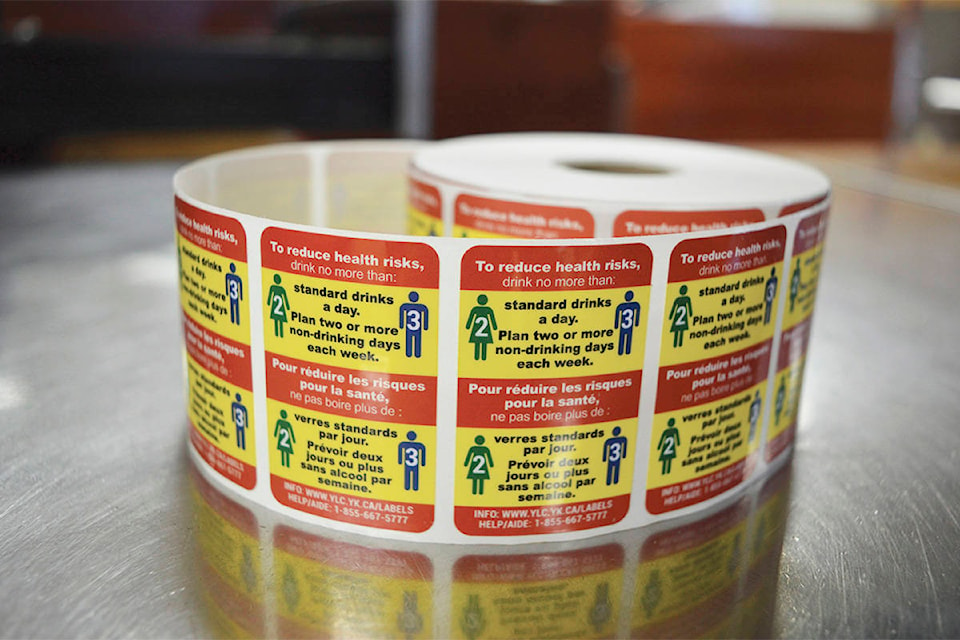Simply-designed, eye-catching labels on alcohol containers in the Whitehorse liquor store helped reduce product sales while increasing consumer awareness on health risks associated with drinking as well as standard drink sizes.
That was one of the findings that came out of a study on the effectiveness of alcohol labels led by the Canadian Institute for Substance Use Research (CISUR) at the University of Victoria and Public Health Ontario, the results of which were published online earlier this week.
The Northern Territories Alcohol Labels Study, saw researchers apply specially-designed labels warning of the link between drinking and cancer to some products at the Whitehorse liquor store beginning in late 2017. It drew national attention when alcohol industry representatives objected to and threatened legal action over the label, causing to the study being put on hold after just one month.
It was resumed in early 2018, this time without the cancer labels but ones showing standard drink sizes and daily drink limit recommendations and continued to July that year.
According to a data analysis, sales on labelled products dropped by 6.6 per cent over the study period, while sales on products in the store without the labels actually increased slightly, by three per cent.
CISUR research associate Kate Vallance said researchers went into the study having “no idea” what impact the labels would have.
“It was a nice surprise to see they actually were effective and they did do the job that we were hoping they would, to better inform consumers about the potential health risks of consuming alcohol,” she said in an interview May 7.
The fact that sales didn’t go down across the store, but in fact increased for non-labelled products, pointed towards the effectiveness of the labels in influencing consumer choices, Vallance said.
“The results of the study have shown that (warning labels) do work and they’re not that hard to implement, they’re not that expensive, they’re very effective, it’s a great way to provide information to consumers because it’s at two points — when you buy it, you see it, and when you drink it, you see it, and so that’s the kind of increased awareness that can happen.”
Vallance said that while researchers had anticipated some resistance from the alcohol industry to the study, they hadn’t anticipated a strong enough of a reaction that industry representatives would actually try to shut down the study.
While unexpected though, she said it wasn’t surprising.
“It really is something that is a threat (to) the whole industry because it requires people to consume and consume a lot of alcohol (in order) to have the sort of global, you know, profits that they currently have,” she said of awareness of the link between alcohol consumption and cancer, and the impact that has on consumer choices.
The industry resistance though, seemed to have backfired, Vallance said, if the goal was to bury alcohol’s link to cancer.
“It might not have been as big, but the funny thing about the industry interference was that I think a lot more people in Canada, not just in Yukon, found out about (the fact that) alcohol causes cancer … It would have been really specific to Whitehorse, essentially, but because of the coverage, it became an international story.”
“The fact that, you know, every other product has to have allergen information and calories and every ingredient listed and the fact that alcohol doesn’t and it’s a class one carcinogen, just like tobacco, is just, it’s quite shocking, really,” she added.
John Streicker, the minister responsible for the Yukon Liquor Corporation, said the Yukon government was reviewing the study results.
He acknowledged that while the cancer labels were what drew the attention, “really, the label we’re most interested in is the low-risk drinking guidelines.”
“And the reason we’re most interested in that label is because we believe that’s where the biggest harms and concerns are with alcohol and that’s true today,” he said.
Streicker said he was a “little surprised” about the reduction of sales, but wondered what impact the media coverage of the study had on getting people to notice the labels more.
“It makes me a little less certain how effective labels are versus a public controversy but I’m happy that the information was getting to Yukoners and I think they probably both had an impact,” he said.
The government hasn’t made a decision yet on whether it will reintroduce either the cancer or drink limit labels, Streicker said. The study results, though he said, may give him a platform to raise the issue again on the national level, which is where he said he thinks the issue on labels, particularly the ones warning of cancer risk, should be handled.
“I think what we’re going to do now is take a look at the studies, have a couple of conversations with the researchers just to pose some questions to them and think through it more thoroughly, and then we’ll take a decision following that,” he said.
Contact Jackie Hong at jackie.hong@yukon-news.com
